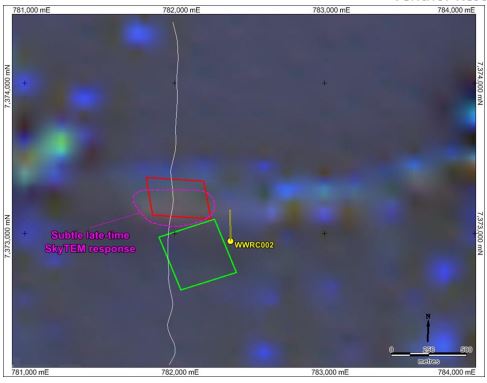Ventnor Resources Limited (ASX:VRX) has identified a bedrock conductor at the Warrawanda Nickel Project in the Pilbara region of WA. The conductor, identified through downhole EM (DHEM) highlights the potential for nickel mineralisation. Further soil geochemistry and ground EM is planned above the interpreted conductor.
- DHEM identifies off hole conductor at Warrawanda nickel prospect Ventnor
Resources Ltd (Ventnor) (ASX: VRX) conducted a Down Hole EM (DHEM) survey on an extended diamond drill hole at its Warrawanda nickel Project 40kms south of Newman in Western Australia.
The diamond hole was extended to conduct the DHEM following evaluation of the diamond core and other supporting geophysical surveys, which indicated a subtle bedrock conductor.
Further work will include another program of soil geochemistry and ground EM above the conductor interpreted from the DHEM.
Managing Director Bruce Maluish said: “The re-evaluation of data at the Warrawanda nickel prospect has generated a new zone that will be evaluated to focus a further drill campaign.”
“Warrawanda has not been a priority exploration area for Ventnor since acquiring the Biranup Project north of Tropicana. This latest work has once again made this area a compelling exploration target for sulphide nickel”, Mr Maluish said.

Detailed Information
Warrawanda is a 17km long ultramafic unit, which the Company believes may host a significant sulphide nickel deposit.
The exploration work that has been undertaken to identify sulphide nickel is as follows;
- SkyTEM airborne electromagnetic survey;
- Drilling of 18 RC holes for 2,859m;
- Field mapping, soil geochemistry and gossan sampling;
- Hymap spectral mapping;
- Review of the GSWA 2013 Capricorn AEM TEMPEST survey;
- Fixed loop electromagnetic (FLEM) surveys;
- Diamond drill tail of Ventnor 2011 RC hole, WWRC002, to 400m; and
- Down hole electromagnetic (DHEM) survey of the extended hole, WWRCD002.

A review of the Company’s SkyTEM data in conjunction with the GSWA 2013 Capricorn AEM TEMPEST survey indicated a potential southerly dipping conductor in the region of WWRC002 drilled in 2011. The multi-element assays from 230m to the end of hole at 250m, indicate the ultramafic was showing nickel depletion, associated with an increase in sulphur and change in the magnesium levels. WWRC002 may have potentially been drilled close to nickel sulphide mineralisation and warranted further investigation.
In September 2016, WWRC002 was extended to 400m by drilling an HQ diamond tail. The core to ~270m was an altered and strongly magnetic ultramafic, with zones of sparsely disseminated pyrrhotite. Subsequently, DHEM survey data was acquired and EM conductor plate modeling completed.
The DHEM data from WWRCD002 detected anomalous EM responses related to off hole bedrock conductors modelled as conductor plates, located to the west of the drill hole. However, the DHEM data is complex and difficult to model, resulting in generally low confidence modelled conductor plates. To improve the confidence in the locations of the modelled conductor plates, their positions and geometries were compared to the digital elevation model (DEM), airborne magnetic results, and airborne EM SkyTEM results. The SkyTEM survey did identify a very faint and subtle EM anomaly corresponding to the modelled DHEM conductor plate locations, see figure below.

Figure: SkyTEM flight line trace L100230 (white line), WWRC002 drillhole collar and trace (yellow dot and line) and DHEM modelled conductor plates projected to surface (red and green rectangles) and the highlighted subtle late time SkyTEM response (hashed pink outline) overlying a SkyTEM EM ternary image, where the late time EM decay channel 25 data are coloured red, channel 20 data are coloured green and mid time channel 15 data are coloured blue (SkyTEM RGB 25-20-15).
The modelled DHEM conductor plate locations correspond to a south dipping late time anomalous response observed in the SkyTEM data. LEI inversion modelling of the SkyTEM data also produced a south dipping zone of slightly elevated conductivity corresponding to the modelled DHEM conductor plate locations, figure below.

Figure: SkyTEM flight line L100230 (782,000 mE) EM decay profiles (top) and corresponding LEI model section (bottom). The LEI inversion identified a S-dipping zone of elevated conductivity corresponding to the modelled DHEM plate locations.



